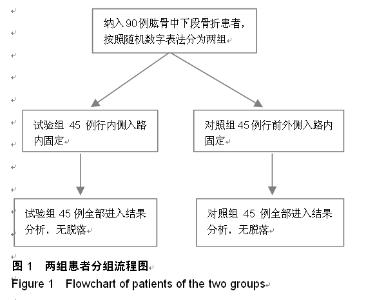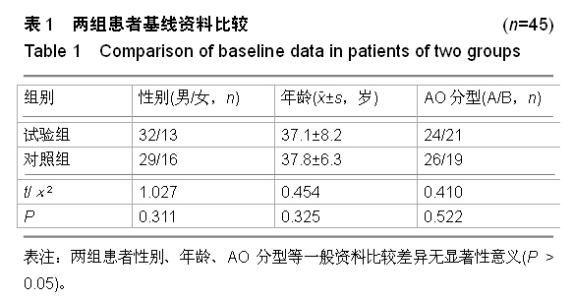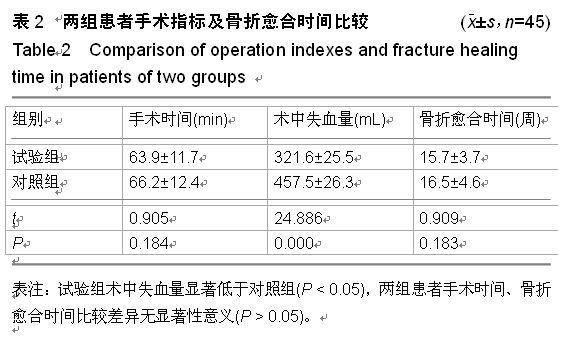| [1] Bonifacio L, Syson P, Llanes J.Revisiting the outcome of displaced two-part fractures of the humeral neck in elderly patients after conservative treatment. Malays Orthop J. 2014; 8(1):57-60.
[2] Krengel WF, Wiater BP, Pace JL, et al. Does using the medial or lateral humeral line improve reliability of baumann angle measurement on plain X-ray? the effect of humeral length visualized on the X-ray. J Pediatr Orthop. 2012;32(4):373- 377.
[3] 兰俊,季卫平,何斌,等.接骨板前内侧固定治疗肱骨中下段骨折的临床疗效[J].实用医学杂志,2011,27(1):79-81.
[4] 王志刚,张弛,周建平,等.双钢板治疗肱骨中下段骨折术后骨不连[J].复旦学报:医学版,2013,40(5):601-605.
[5] 林洪光,陈昆,王鸿泰,等.改良上臂前外侧入路治疗肱骨中下段骨折[J].实用骨科杂志,2013,19(11):978-979,983.
[6] Adolfsson L, Nestorson J.The Kudo humeral component as primary hemiarthroplasty in distal humeral fractures. J Shoulder Elbow Surg. 2012;21(4):451-455.
[7] Hoffmann M, Scroeder M, Kossow K,et al.Radiological dorsal tilt analysis of AO type A, B, and C fractures of the distal radius treated conservatively or with extra-focal K-wire plus external fixateur. Skeletal Radiol. 2012;41(9): 1133-1139.
[8] Hohmann E, Hansen T, Tetsworth K.Treatment of Neer type II fractures of the lateral clavicle using distal radius locking plates combined with Tight Rope augmentation of the coraco-clavicular ligaments. Arch Orthop Trauma Surg. 2012; 132(10):1415-1421.
[9] Morrey BF,Chao EY.Functional evaluation of the elbow// Morrey BF,ed.The elbow and its disorders). Philadelphia: WB Saunders,1985:73-91.
[10] Clinton J, Franta A, Polissar NL,et al.Proximal humeral fracture as a risk factor for subsequent hip fractures. J Bone Joint Surg Am. 2009;91(3):503-511.
[11] 姚保兵,王文德,李宗宝,等.前方入路钢板前置内固定治疗肱骨中下段骨折[J].中华创伤骨科杂志,2009,11(1):83-84.
[12] 王伟,艾尔肯•玉麦尔,张青春,等.内外侧切口入路植入物内固定治疗肱骨中下段骨折[J].中国组织工程研究,2014,18(9): 1459- 1464.
[13] 陈刚,吴农欣,廉凯,等.外侧入路双LCP治疗肱骨中下段骨折的疗效分析[J].中国骨与关节损伤杂志,2013,28(11):1080-1081.
[14] 曾俊,郭勇,钟泽莅,等.两种手术方式治疗肱骨中下段骨折疗效比较[J].实用骨科杂志,2014,20(6):543-546.
[15] 戴鹤玲,孙天胜,刘智,等.应用ACUMED自主定向肘关节骨板系统治疗成人肱骨远端C型骨折[J].中华创伤杂志,2013,29(2): 132-135.
[16] 邢丹谋,任东,彭正人,等.有限切开锁定加压钢板内固定加异体骨植入治疗复杂性肱骨干骨折[J].中华手外科杂志,2013,29(1): 1-3.
[17] 郑华,何盛江,王群波,等.锁定钢板加同种异体骨移植治疗老年肱骨近端骨折[J].创伤外科杂志,2012,14(2):130-132.
[18] 王一民,徐开明,黄醒中,等.髓内钉置入内固定治疗肱骨骨折[J].中国组织工程研究,2013,17(4):696-703.
[19] 安永刚,乔文海,邹海军,等.闭合复位克氏针交叉内固定治疗儿童肱骨髁上骨折[J].创伤外科杂志,2013,15(1):4-4.
[20] 杨成亮,叶书熙,樊仕才,等.肱骨近端LCP(PHILOS)内固定结合自体骨移植治疗肱骨上段骨折术后骨不连[J].中国骨与关节损伤杂志,2012,27(1):66-67.
[21] 胡稷杰,金丹,魏宽海,等.肱骨近端锁定钢板或肱骨近端内锁定系统与其他内固定治疗肱骨近端骨折的Meta分析[J].中华创伤骨科杂志,2012,14(12):1047-1054.
[22] 沈彦,王朝阳,吴兴旺,等.不同手术方式治疗肱骨远端骨折的疗效观察[J].创伤外科杂志,2015,17(3):217-221.
[23] 李路平,何耀文,任意平,等.小切口锁定加压钢板治疗老年人肱骨近端骨折[J].中华创伤骨科杂志,2012,14(4):353-354.
[24] 黄佳平,康两期,周亮,等.交叉克氏针固定治疗Ⅰ型肱骨小头骨折[J].临床骨科杂志,2013,16(6):723-723.
[25] 赵瑛,鲍晓毅,尹志强,等.双钢板固定术治疗肱骨远端骨折74例分析[J].重庆医学,2014,43(1):42-43,47.
[26] 蓝耿亮,谭仁林,王照卿,等.后外侧切口加内侧切口入路手术治疗三踝骨折26例分析[J].广西医科大学学报,2013,30(4): 624-625.
[27] 冯小兵,黄伟松,郑容生,等.前内侧切口联合内侧及前侧锁定钢板内固定治疗累及前踝和内踝的Pilon骨折[J].中国骨与关节损伤杂志,2013,28(8):788-789.
[28] 李增春,李国风,韩宁,等.经内侧入路治疗胫骨平台后内侧骨折的手术疗效[J].复旦学报:医学版,2012,39(2):172-175,193.
[29] 胡飞,尚希福,姚刚,等.髌旁内侧显露切开复位内固定治疗粉碎性髌骨骨折[J].中国骨与关节损伤杂志,2014,29(1):69-70.
[30] 何民, 唐金平,王文龙,等.内、外侧入路治疗肱骨干中下段骨折的疗效比较[J]. 实用骨科杂志,2014,20(12):1123-1124,1125.
[31] 蒋曙,尹善青,郭晓山,等.后内外不同入路治疗内侧延伸型后踝骨折疗效比较[J].中国骨伤,2014,27(6):496-499.
[32] Sohn HS, Shin SJ. Minimally invasive plate osteosynthesis for proximal humeral fractures: clinical and radiologic outcomes according to fracture type. J Shoulder Elbow Surg. 2014;23(9): 1334-1340.
[33] Lowe JB, Monazzam S, Walton B, et al.How to Use Fluoroscopic Imaging to Prevent Intra-articular Screw Perforation During Locked Plating of Proximal Humerus Fractures: A Cadaveric Study.J Orthop Trauma. 2015. [Epub ahead of print]
[34] Tsitsilonis S, Schaser KD, Kiefer H, et al.The treatment of the proximal humeral fracture with the use of the PHN Nailing System: the importance of reduction.Acta Chir Orthop Traumatol Cech. 2013;80(4):250-255.
[35] Zhang L, Zheng J, Wang W, et al. The clinical benefit of medial support screws in locking plating of proximal humerus fractures: a prospective randomized study. Int Orthop. 2011; 35(11):1655-1661.
[36] Chaudhary S, Patil N, Bagaria V, et al.Open intercondylar fractures of the distal humerus: Management using a mini-external fixator construct. J Shoulder Elbow Surg. 2008; 17(3):465-470.
[37] Cazeneuve JF, Cristofari DJ.[Grammont reversed prosthesis for acute complex fracture of the proximal humerus in an elderly population with 5 to 12 years follow-up].Rev Chir Orthop Reparatrice Appar Mot. 2006 ;92(6):543-548.
[38] Tingart MJ, Lehtinen J, Zurakowski D, et al.Proximal humeral fractures: regional differences in bone mineral density of the humeral head affect the fixation strength of cancellous screws.J Shoulder Elbow Surg. 2006;15(5):620-624.
[39] Pajarinen J, Björkenheim JM.Operative treatment of type C intercondylar fractures of the distal humerus: results after a mean follow-up of 2 years in a series of 18 patients.J Shoulder Elbow Surg. 2002;11(1):48-52.
[40] Schulte LM, Matteini LE, Neviaser RJ. Proximal periarticular locking plates in proximal humeral fractures: functional outcomes.J Shoulder Elbow Surg. 2011;20(8): 1234-1240.
[41] Fallatah S, Dervin GF, Brunet JA, et al.Functional outcome after proximal humeral fractures treated with hemiarthroplasty. Can J Surg. 2008;51(5):361-365. |









